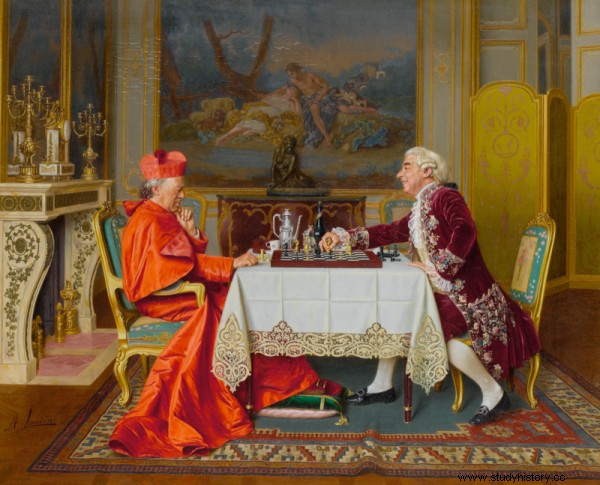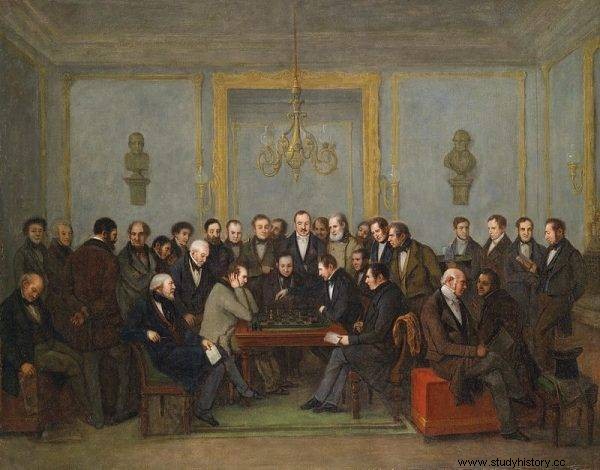A strategic board game that both rulers and women admired. Tactics, manipulations, intuition - today, thanks to this particular game, we can understand the changes taking place in art, politics and culture. How was the phenomenon of chess born, not without reason called royal?
Nowadays, India is considered the home of chess. Because already in the 6th century AD, so-called chaturanga was played there. In fact, the oldest remains of board games come from the Middle East.
Apparently, at Persian courts, Chaturanga appeared as a diplomatic gift thanks to Hindu rajahs. Relatively quickly it was transformed into chatrang in Persia, and then - when the Persian empire was conquered by the Arabs - into shatrang. This unusual entertainment came to Europe in the 8th and 9th centuries and became the prototype of modern chess.
Fighting in the courts
It was European players who decided to additionally modify the rules of the game, define the rules of movement of the pieces, and clarify what exactly is castle or checkmate. Although it should be emphasized that the inhabitants of the Old Continent have enjoyed the achievements of Arab chess players for a long time.
The real fashion for chess came during the Renaissance, especially in Spain and Italy, reaching its heyday at the turn of the 16th and 17th centuries. Interestingly , in 1564 Jan Kochanowski published an original poem entitled simply "Chess" - the first in the history of Polish literature entirely dedicated to the royal game.

The real fashion for chess came during the Renaissance, especially in Spain and Italy
Although the war symbolism of individual pieces was already present in Indian chess variants, in which there was a king and a vizier, two elephants, chariots and horses, and footmen, or pawns, military imagery was especially developed in the areas of Medieval and Renaissance Europe.
Suffice it to say that chess was included in the canon of royal textbooks , the vizier was replaced by the queen, the bishop ousted the elephant, and the chariots were transformed into towers. The game gained importance thanks to the analyzes of eminent theoreticians and chess players such as Gioachino Greco, Ruy Lopez and Alessandro Salvio.
Championship tournaments
Strategy, tactics, intuition, calculation ... duels of chess masters during the European revival aroused the interest of more and more social groups. There were clubs and associations, tournaments were organized from time to time. Over the centuries, the game did not lose its importance, on the contrary - it gained a cultural importance.
The first champions, kings of chess, began to appear on the international arena:in England - Howard Staunton, in Russia - Alexander Petrov, in France - Louis de la Bourdonnais, in Germany - Adolf Anderssen, and in the United States - Paul Morphy.

Howard Saunton's game against Pierre Saint-Amante
In 1886, the first official match for the world title was played between the Polish-German chess player of Jewish origin, Johannes Zukertort, and Wilhelm Steinitz from the USA (the winner was Steinitz). The competition brought special emotions. The International Olympic Committee also recognizes chess as a sport. A discipline practiced by the great and powerful of the world.
Charles VII Valentius, for example, played chess with his mistress Agnès Sorel. The Russian tsars were also real enthusiasts of this entertainment - Ivan the Terrible was supposed to give up his spirit during the party, and Peter the Great valued his passion so much that he made a set of figures and pawns out of wood.
A brilliant robot and political games
An avid player, though not particularly outstanding, was supposed to be Napoleon Bonaparte, who visited the famous Café de la Régence for this purpose. The French ruler played one of the games with the so-called The Clockwork Turk, the genius machine of the Hungarian engineer Wolfgan von Kempelen (in the center of the device was actually a talented chess player; for example, Johann Allgaier or Alexandr Deschapelles were involved in the fraud).
The Mechanical Turk played duel with such figures as Benjamin Franklin and Charles Babbage, an English mathematician, creator of the logarithmic table, sometimes referred to as "the father of all computers".
Politicians and thinkers, such as Machiavelli and Cardinal Richelieu, and more recent ones - Lenin, Marx and Castro, also sat at the chess board. Neither Tsarina Catherine the Great nor Jan III Sobieski, as well as Winston Churchill, Pope Leo X, Henryk Sienkiewicz and Leo Tolstoy, did not hide their passion for the royal game.
Bibliography:
- Litmanowicz, J. Giżycki, Chess from A to Z , volume I, Sport i Turystka Publishing House, Warsaw 1986.
- Huizinga, Medieval Autumn, Vis-á-Vis / Etiuda Publishing House, 2016.
- Czajkowski, A. Nowicki, Three steps into the chess world. Principles and nuances of the royal game, BIS publishing house, 2020.
